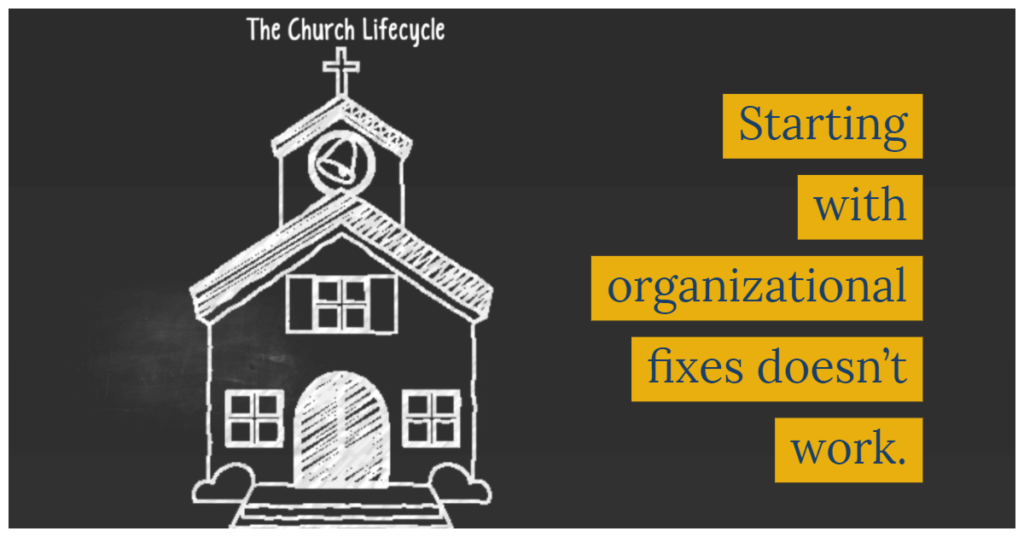Continuing in a short series of articles, I’m going to share with you some of the most helpful information about revitalizing a church that I’ve ever learned:
When God revitalizes a church, he takes them through 5 types of renewal. These NEVER happen out of order.
1. Personal Renewal
2. Relational Renewal
3. Missional Renewal
4. Structural Renewal
5. Cultural Renewal.
That’s a pretty bold statement but I’ve found it to be true. Last week, I shared about the Great Commission and missional renewal in the church.
In this article I want to address the fourth renewal, structural renewal.
When a church realizes it needs revitalization, it is typically in the Church Life Cycle stage of “Decline.” Where, as opposed to a church in the “Incline” stage that is vision-driven, future-oriented, and focused on reaching the outside community for Christ, a church in decline tends to be structure-driven, past-oriented, and focused on keeping the existing core members in place. Since a church in decline tends to be more focused on itself, it makes sense that when they decide to seek revitalization, their first instinct is to go straight to this fourth renewal and skip over the first three.
The thought is usually something like this:
“If we can just tweak a few things here and there organizationally everything will get better. If we reorganize our committees and put new people in charge then we’ll start growing again, or if we put a new and better sign out front that will bring in young people with children. Let’s put a committee together.”
Or, unfortunately, another common, quick, organizational fix is, “if we just get a new priest or youth minister or some other staff person then they’ll fix it.”
Starting with organizational fixes doesn’t work. Remember the premise of my article. God revitalizes a church he takes them through 5 types of renewal. These NEVER happen out of order. Structural Renewal is part of church revitalization, it is just not the place to start. Rather, structural renewal is a natural result of the first three areas being renewed.
When a congregation develops a real love for God (personal renewal), a real love for one another (relational renewal), and a real love for non-believers with a willingness to do whatever it takes to reach them and bring them into God’s Kingdom so they can be Jesus’ disciples too (missional renewal), then it will get back on “Incline.” Then, when the church begins to grow, structural renewal takes place.
I think the clearest Biblical example of this is in Acts 6. As you read through Acts 2-5 you see the first three renewals happening. As a result, the church rapidly grows. What worked organizationally for the original 120 or so disciples and then for the 3,000 added on Pentecost, suddenly hit an obstacle.
“In those days when the number of disciples was increasing, the Hellenistic Jews among them complained against the Hebraic Jews because their widows were being overlooked in the daily distribution of food. So the Twelve gathered all the disciples together and said, ‘It would not be right for us to neglect the ministry of the word of God in order to wait on tables. Brothers and sisters, choose seven men from among you who are known to be full of the Spirit and wisdom. We will turn this responsibility over to them and will give our attention to prayer and the ministry of the word.’ This proposal pleased the whole group. They chose Stephen, a man full of faith and of the Holy Spirit; also Philip, Procorus, Nicanor, Timon, Parmenas, and Nicolas from Antioch, a convert to Judaism. They presented these men to the apostles, who prayed and laid their hands on them. So the word of God spread. The number of disciples in Jerusalem increased rapidly, and a large number of priests became obedient to the faith.” Acts 6:1-7
Notice in the last two sentences, “So the word of God spread. The number of disciples in Jerusalem increased rapidly…” Because they didn’t ignore the complaints of growth but collaboratively addressed the problem and renewed their organizational structure, the growth continued.
As your church is renewed and begins to grow again, you will find that what organizationally works with 20 members won’t work with 50. What works with 50 won’t work with 100. And what worked with 100 won’t with 200. Structural renewal will need to continually be addressed to allow growth to continue. Structure won’t cause growth, but it will either limit or allow growth.
Is it time to look at your organizational structure and make necessary changes to continue growing? There’s a great quote that I read from Dallas Willard though others have said similar things, “Your current system is perfectly designed to get you the results you are getting.” If your church has 40 or 70 or 200 members, that’s likely what your current system will allow. Presupposing the first three renewals are in effect, here are some structural renewal ideas from Acts 6 to apply as needed.
1. Pay attention to complaints. Just as pain in my body is God’s way of letting me know there is something wrong that needs to heal, complaining in a growing, missional church can be an indication of a structural change that needs to be addressed. That was the case in Acts 6. The complaining led to an organizational change that allowed for more growth. Sure, sometimes people complain just to complain. However, it’s worth taking the time to analyze the complaining to see if there is a legitimate “pain” in the church body that God is bringing to the surface to be addressed for the greater health and growth of the congregation.
2. Be willing to change. If you are not willing to let go of “the way we’ve always done it” then you’ll limit growth. This is why the first three renewals are required. If your relationship with God is so rich and good that you are finding your identity and security in him, not the church, then the church can change, and you’ll be okay! If you’re looking to the church, not Jesus, for that security, then you’ll likely resist change in order to protect your own sense of security. Similarly, if you sincerely love lost sinners then you’ll do whatever it takes to reach even one more – whatever it takes – including changing structures. Developing a culture of change in a growing church is essential. The Apostles modeled this for us in Acts 6, may we continue as they led the way.
3. Work collaboratively toward solutions. The days of “father knows best” in the church are gone. The culture has changed so rapidly that things that worked even 10 years ago aren’t working anymore! Maybe 20 or 30 years ago when our culture was by and large more Christian, a church could “plug and play” the latest church growth model and see some success. However, today, there are no easy solutions or quick fixes for church growth. As your church faces structural challenges, a collaborative approach is appropriate. In Acts 6 it says, “So the Twelve…” called the rest together with the solution, then, “This proposal pleased the whole group.” It implies that they got together and discussed it under the guidance of the Holy Spirit and were collaborative. If guided by the Holy Spirit, a collaborative effort of clergy, staff, vestry, and even outside consultants at times, will bring to light the best solutions to keep the growth going.
4. Let go of control. Again, the Apostles modeled for us how to practice structural renewal. They said, “Brothers and sisters, choose seven men from among you who are known to be full of the Spirit and wisdom. We will turn this responsibility over to them…” They didn’t try to do everything themselves! They knew their calling and delegated the rest. In my first eight years of ordained ministry, I experienced an average of 10% growth a year in two different churches. In the ninth year we didn’t grow. I was devastated. I brought in a consultant to address what I thought was a structural renewal issue. Well, there was an issue, but it turned out the issue was me! My unwillingness to delegate in several areas was bottlenecking the growth. I was even more devastated! However, with my love for lost people and commitment to do whatever it took to see sinners saved, I endeavored on a personal journey of healing and growth in order to learn to let go of control. I had to grow for the church to continue to grow. If you struggle letting go of control, I implore you, for the sake of others, lean into the Lord and let him change that in you. And as the Apostles did, turn some responsibility over to wise, Spirit-filled disciples.
The Rev. Canon Mark Eldredge is Director of Church Revitalization and Coaching for the American Anglican Council. If you would like to know more about ReVive! Church Revitalization, go to www.ChurchRevive.org or contact Mark+.


